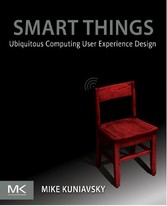Search and Find
Service
Smart Things - Ubiquitous Computing User Experience Design
The world of smart shoes, appliances, and phones is already here, but the practice of user experience (UX) design for ubiquitous computing is still relatively new. Design companies like IDEO and frogdesign are regularly asked to design products that unify software interaction, device design and service design -- which are all the key components of ubiquitous computing UX -- and practicing designers need a way to tackle practical challenges of design. Theory is not enough for them -- luckily the industry is now mature enough to have tried and tested best practices and case studies from the field.
Smart Things presents a problem-solving approach to addressing designers' needs and concentrates on process, rather than technological detail, to keep from being quickly outdated. It pays close attention to the capabilities and limitations of the medium in question and discusses the tradeoffs and challenges of design in a commercial environment. Divided into two sections, , frameworks and techniques, the book discusses broad design methods and case studies that reflect key aspects of these approaches. The book then presents a set of techniques highly valuable to a practicing designer. It is intentionally not a comprehensive tutorial of user-centered design'as that is covered in many other books'but it is a handful of techniques useful when designing ubiquitous computing user experiences.
In short, Smart Things gives its readers both the why of this kind of design and the how, in well-defined chunks.
* Tackles design of products in the post-Web world where computers no longer have to be monolithic, expensive general-purpose devices
* Features broad frameworks and processes, practical advice to help approach specifics, and techniques for the unique design challenges
* Presents case studies that describe, in detail, how others have solved problems, managed trade-offs, and met successes
All prices incl. VAT














